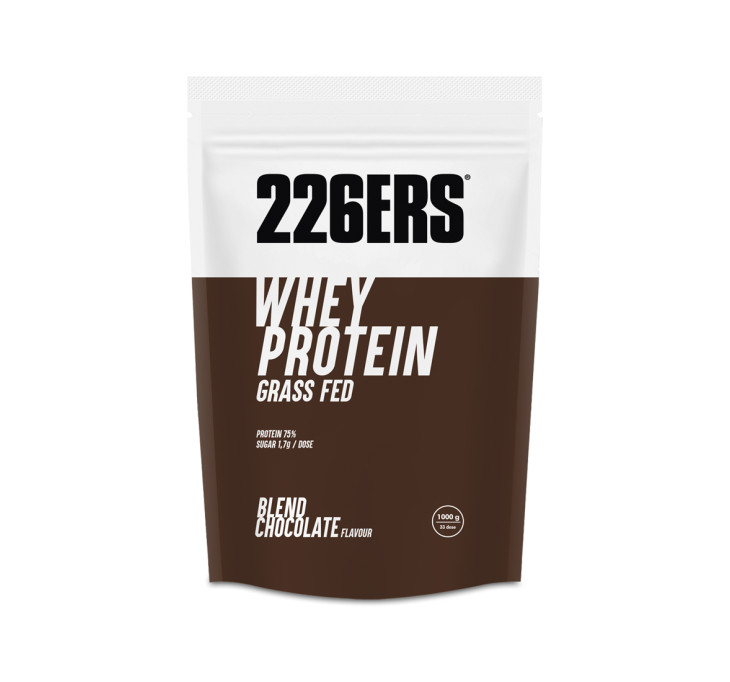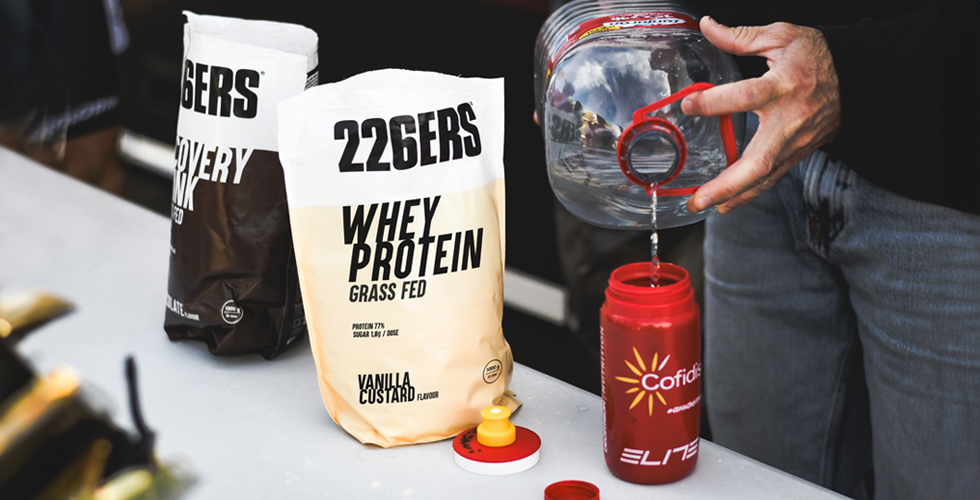Tabla de contenidos
ToggleEs bastante frecuente en el contexto deportivo, y concretamente dentro del ámbito de la suplementación, oír hablar sobre la “proteína” o “whey protein”. Pero, ¿realmente se conocen las pautas correctas de uso para optimizar el rendimiento deportivo?. Por ejemplo, qué tipo de proteína, cuándo tomarla, cómo tomarla, en qué dosis, con qué objetivo, etc.
This article will aim to clear all these concepts so the consumer gets all the relevant information in order to intake this supplement in the best possible manner.
What’s whey protein?
Proteins are macronutrients with a clear structural function, i.e. their role is to create and regenerate tissues, hence its intake is essential for muscle gain, growth and tissue repair. All these aspects make protein intake key for athletes, either to gain muscle mass or recover from exercising.
Proteins are usually taken with the athlete’s common meals; eggs, meat, fish, dairy or vegetable sources like peas, nuts and soya.
So, if proteins can be taken with food, why would you demand protein supplements? Well, for various reasons:
- Because the dietary protein intake might not be enough in some cases.
- To increase the availability of amino acids in the blood stream.
- For logistic reasons, since many times an athlete may not have access to natural food after training or competing.
Or even for all the previous reasons. It’s therefore that protein shakes or protein powders called ‘whey protein’ are required but, what is it really? Well, simply protein extracted from milk.

WHEY PROTEIN - Grass Fed Protein Shake - 1000g
Whey Protein is a food supplement powder based on whey protein concentrate. Suitable for vegetarian diets, it is gluten-free, high in protein and low in fat and carbohydrates. It is formulated with GRASS FED Whey Protein Concentrate as the main ingredient. It provides 23g of protein and less than 1.9g of sugar per serving.
Whey protein comes from milk’s whey, usually from cows. After an acidifying process, whey is separated from the milk, and after drying out the liquid, the product is sold as a powder called WHEY PROTEIN.
Are all whey protein products the same? The answer is no, It depends on the concentration of proteins it contains and therefore, there are four kinds of ‘protein’:
- Whey protein: contains 30 to 80% protein
- Concentrated whey protein: ensures 80% protein
- Isolated whey protein: ensures 90% protein after an additional manufacturing process that removes fats and sugars
- Hydrolised whey protein: pre-digested protein for a claimed better absorption
Basically, the difference between them lies in their price, flavour and protein quality, being advisable to use mostly 75 to 90% whey protein concentration.
The quality of these products are based in the inclusion of all the essential amino acids, against other protein products or products that only contain some amino acids, such as casein or branched chained amino acids (BCAA).

WHEY PROTEIN - Grass Fed Protein Shake - 1000g
Whey Protein is a food supplement powder based on whey protein concentrate. Suitable for vegetarian diets, it is gluten-free, high in protein and low in fat and carbohydrates. It is formulated with GRASS FED Whey Protein Concentrate as the main ingredient. It provides 23g of protein and less than 1.9g of sugar per serving.
How to take whey protein?
The first thing to know before taking protein is the goal for it and which are the daily protein intake requirements, as well as the sport practiced.
Taking all this into account, it’s possible to make the following classification:
Strength sports
They usually aim for an increase or maintenance in muscle mass. An intake of 2 to 3 grams of protein per kilogram of body mass is advisable.
Endurance sports
These have a lower demand of protein intake, about 1,5 to 2 grams of protein per kilogram of body mass. Nevertheless, in nutrition or training plans which aim to reduce fat or increase muscle mass, these amounts can vary and increase up to 2 to 2,5 grams of protein per kilogram of body mass.
Having in mind these references, and calculating the total daily requirements, whey protein can be added to that total protein intake. For example:
- 90 kg strength athlete = 180 to 270 grams of protein intake daily
- 70 kg endurance athlete = 105 to 175 grams of protein intake daily
Thus, taking a standard whey protein shake throughout the day, would include 22 grams of high quality protein with essential amino acids rich in leucine. This amount should be deducted from the total daily protein requirement, with the rest being provided mainly by the diet.
Protein shakes are usually prepared in water, however, some athletes prepare them with milk, this leads to having to take into account that the nutritional composition of the shake would change, adding calories, fats, carbohydrates and of course more protein.
The following chart compares the composition of a whey protein shake made with water, against the same shake prepared with 250 ml of semi-skimmed milk
.
| Product | Whey protein 226ers + 250 ml water | Whey protein 226ers + 250 ml semi-skimmed milk |
| Energy (Kcal) | 118 | 225 |
| Protein (g) | 22 | 31 |
| Carbohydrates (g) | 2 | 14 |
| Fat (g) | 2 | 6 |
When to take whey protein?
To establish the appropriate moment or time to take a whey protein shake, it’s necessary to consider two things:
- Recommended protein intake timing
- Specific needs of the workout
Concerning the first, it’s important that the organism is constantly ‘repairing and creating’ tissues, which means that protein intake must be continuous and at regular 4 to 6 hour intervals. This implies that the day times to take protein would be:
- Breakfast
- Morning snack / workout
- Lunch
- Evening snack / workout
- Dinner
- Bedtime
Taking the previous examples, the advised timing for an athlete to intake protein would be:
- 90 kg strength athlete = 180 to 270 grams of protein intake daily
The total amount is split into 6 intakes, which implies that each should provide approximately 30 to 45 grams.
- 70 kg endurance athlete = 105 to 175 grams of protein intake daily
The amount is split into 5 or 6 intakes, which implies that each should provide approximately 20 to 30 grams.
From this point of view, lunch and dinner wouldn’t be the adequate time to add a whey protein shake, since it’s already quite easy to include a natural protein source through food. Therefore, protein shakes would be left for breakfast, snacks or bedtime.
If you are interested in incorporating Whey Protein into your routine, we invite you to explore our protein category, where you will find a variety of options to improve your performance and achieve your nutritional goals.
How’s the optimum time decided?
Easy. First of all, you should avoid eating only protein shakes, so it’s advisable to limit these products to 1 or 2 per day, and training needs should also be taken into account.
Whey protein shakes can be used to enrich breakfast if the athlete’s usual food choice doesn’t satisfy the protein requirements, or taking a shake before bedtime to favour anabolism and recovery on the most intense weeks of training.
Nevertheless, it’s preferable to prioritise the whey protein shake when you train, which is the time when the availability speed of amino acids in the blood stream can be important to recover or assimilate the workout. So, if an athlete has a morning or afternoon training session, he can take advantage of this whey protein shake at the end of the workout, or even during its course, if it’s a strength training session.
Another advised option to take a protein shake would be during fasted workouts, in order to preserve muscular mass and to avoid muscular catabolism.





